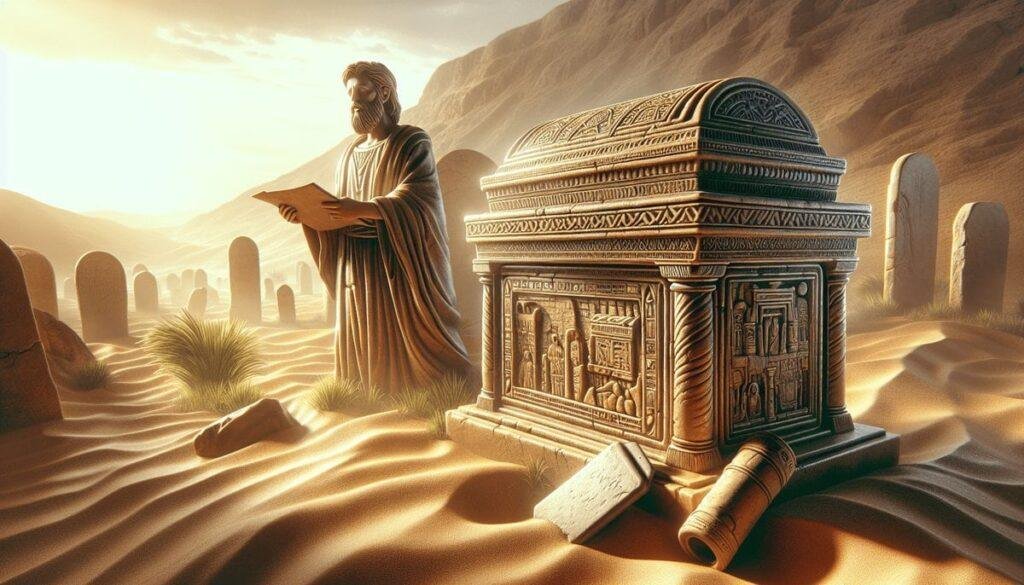What if the secrets of an ancient sect, hidden for centuries, began to reveal themselves piece by piece? Imagine uncovering the initiation rites of the enigmatic Qumran community, famously linked to the Dead Sea Scrolls. Let’s take a leisurely stroll through the intriguing labyrinth of biblical archaeology and uncover what lies beneath the surface.

The Qumran Community: A Glimpse into the Past
The Qumran community certainly knew how to keep a secret. Nestled along the shores of the Dead Sea, this group of Jewish ascetics lived a life set apart from the hustle and bustle of the Roman Empire. Around the mid-second century BCE, they made their home in a place buzzing with quiet contemplation and spiritual devotion.
Their practices included rigorous communal living, strict adherence to religious laws, and, of course, a strong belief in impending apocalyptic events. But who were they, and what did that mean for the world of biblical scholarship?
A Historical Snapshot
Before diving deep into their rituals, it’s crucial to sprinkle in a bit of historical context. The Qumran community flourished amid the tumultuous landscapes of Second Temple Judaism. Think of them as ancient social reformers, disillusioned with the Temple priesthood.
- Key Timeframe: Roughly 150 BCE to 68 CE
- Location: Near the Dead Sea, Palestine
- Belief System: An esoteric interpretation of Jewish law, emphasizing purity and communal living.
While their ideology may sound familiar, the Qumranites often had radically divergent views from mainstream Judaism. They were, in many ways, the original “separatists,” seeking to create a purer form of worship.
The Dead Sea Scrolls: A Treasure Trove of Wisdom
Nothing defies the ages quite like the Dead Sea Scrolls. Discovered between 1947 and 1956, these ancient manuscripts contain biblical texts, sectarian writings, and commentaries that unlock the door to the community’s belief systems and daily life.
They weren’t just scribbled notes; they were sacred texts that offered insights into the Qumran community’s thoughts on piety, repentance, and spiritual readiness.
Content Overview
The scrolls include:
- Biblical Texts: Early copies of books from the Hebrew Bible.
- Sectarian Writings: Documents specific to the Qumran community, revealing their rules and regulations.
- Commentaries: Interpretations that shed light on their understanding of scripture.
These scrolls are vital for understanding the socio-religious landscape of ancient Judea, offering a window into the beliefs and practices of a community striving for purity amidst chaos.
Unpacking the Qumran Scraps Crate
Now, let’s focus on the tantalizing discovery sometimes referred to as the Qumran scraps crate. A repository of intriguing manuscripts and artifacts, this crate has managed to captivate biblical scholars and history enthusiasts alike.
What Was Found?
The best part? The crate held fragmented scrolls, each containing vital information about the initiation processes practiced by the Qumran sect.
- Ritual Instructions: Guidelines for new members regarding their obligations and lifestyle.
- Purification Practices: Steps illustrating the emphasis placed on ritual cleanliness.
- Teachings on Community Values: Essential beliefs about sharing and living communally.
Why It Matters
Understanding these fragments can change the way we perceive spiritual initiation. The Qumranites viewed initiation not just as a formality but as a transformative experience leading to a deeper relationship with the divine.

Initiation Rites: Pathways to Spirituality
So, what did it mean to be initiated into the Qumran community? This wasn’t just a casual handshake and a welcome coffee. Instead, it involved a series of rigorous steps designed to spiritually cleanse and prepare individuals for their new life among the community.
Ritual and Symbolism
At the heart of these initiation rites were practices rich in symbolism and purpose. Ritual washing, referred to as mikveh, was essential for spiritual purification, while a communal meal symbolized the bond between community members.
Key Components of Initiation
| Component | Description |
|---|---|
| Ritual Washings | Performed to symbolize purification before joining. |
| Test of Knowledge | New members were quizzed on community beliefs. |
| Community Feast | A celebratory meal emphasizing unity and sharing. |
The Spiritual Toolkit
Each step served as part of a spiritual toolkit, equipping initiates with the tools needed for a life dedicated to holiness and communal living. It was all about preparing individuals not only to join the community but to embody its values deeply.
Hunting for the Subtext: Insights from the Initiation Rites
Now, one might wonder how these rites relate to modern spirituality or even contemporary religious practices. Just as much as they were about rituals, they were about community, identity, and belonging.
Identity and Belonging
The Qumranites believed that initiation was an act that shaped individual identity. When you were initiated, it wasn’t just about you; it was about your relationship with the community and, ultimately, with God.
- Covenantal Relationship: You entered into a sacred covenant, reinforcing communal ties.
- Collective Identity: Each initiate became part of a larger story, knitting personal and communal threads into a sacred tapestry.
Lessons for Modern-Day Spirituality
While many may not find themselves heading to a remote desert community, the essence of initiation remains relevant. Consider how groups today still emphasize transformative experiences—whether through baptism, conversion ceremonies, or other forms of spiritual commitment.
The Role of Scripture in Initiation
Scriptural texts also played a vital role in the initiation process, acting both as guidelines and inspiration for the initiates. This connection between text and practice is something that resonates through the ages.
Text as Authority
The Qumran community revered their scriptures, often interpreting them through the lens of their unique beliefs. Scripture was not merely historical or literary; it was the very foundation of their lived experience and commitment.
Key Scriptural Influences
| Influence | Description |
|---|---|
| Prophets | Writings that foretold a coming age, influencing belief. |
| Law Codes | Guidelines that shaped daily living and communal laws. |
| Wisdom Literature | Offers insights into ethics and moral conduct. |
Interpretations That Matter
Through their unique lens, distinct interpretations emerged, paving the way for specialized teachings that governed daily life and spiritual obligations. This attention to scripture offers a fascinating parallel to many modern religious movements that rely heavily on sacred texts to guide and structure communal life.
The Cultural and Historical Contexts
Walking the historical corridors of Qumran gives us insight into a culture shaped by the tension of religious fidelity amidst a politically charged landscape.
The Roman Influence
The looming presence of Rome cast a long shadow over the Qumran community. Their strict adherence to purity laws often set them at odds with the more secular practices supported by the Roman Empire.
- Crisis of Identity: This tension fueled their desire to distance themselves and form a unique identity.
- Theological Divergence: Their beliefs often diverged sharply from those widely accepted at the time, emphasizing apocalypticism and ritual purity.
The Socio-Religious Climate
The greater socio-religious climate was ripe for experimentation and reformulations of beliefs. The Qumran community stands as a testament to the human search for meaning, even amid societal chaos.
Parallels in Modern Spiritual Movements
As you consider the Qumran community and their initiation rites, it’s enlightening to identify parallels in contemporary spiritual movements.
Community-Centric Practices
Many modern spiritual organizations emphasize communal living or shared beliefs, mirroring the essence of the Qumran community. Initiation practices in various religions often place a significant focus on joining a community.
- Workshops and Retreats: Like the communal meals of Qumran, today’s workshops cultivate a sense of shared journey.
- Ceremonies of Commitment: Just as Qumranites underwent rigorous initiations, many today find themselves participating in elaborate ceremonies symbolizing their commitment to community.
Scriptural Reverence
The resonating power of scripture remains strong. Churches, groups, and spiritual gatherings often use sacred texts as guiding principles for their practices, echoing the Qumran community’s deep reliance on scripture.
Closing Thoughts: Bridging the Ancient and Modern
As we reflect on the Qumran community’s initiation rites, there’s much to consider about how these ancient practices continue to shape contemporary spirituality. The secrets of the Qumran scraps crate reveal more than just historical curiosities; they resonate with ongoing quests for meaning.
The continued fascination with the Qumran community stems from a universal human desire for connection, purity, and purpose. Understanding their practices offers a rich tapestry of insights not just related to ancient history but to modern spiritual exploration.
So, as you ponder the ancient secrets of Qumran, remember that their journey continues, not just in the pages of dusty scrolls but within the ever-evolving landscape of human spirituality. Perhaps there’s a piece of Qumran in all of us, searching, yearning, and reaching for deeper truths amid the clamor of life.


